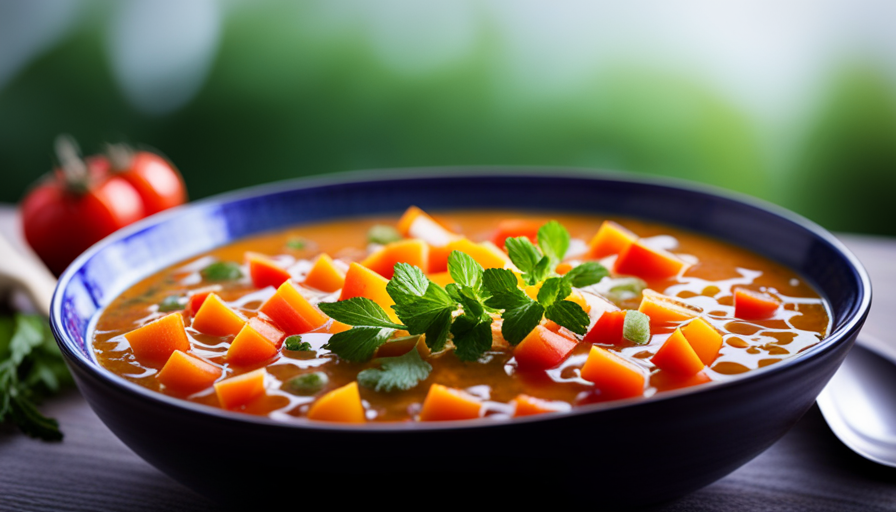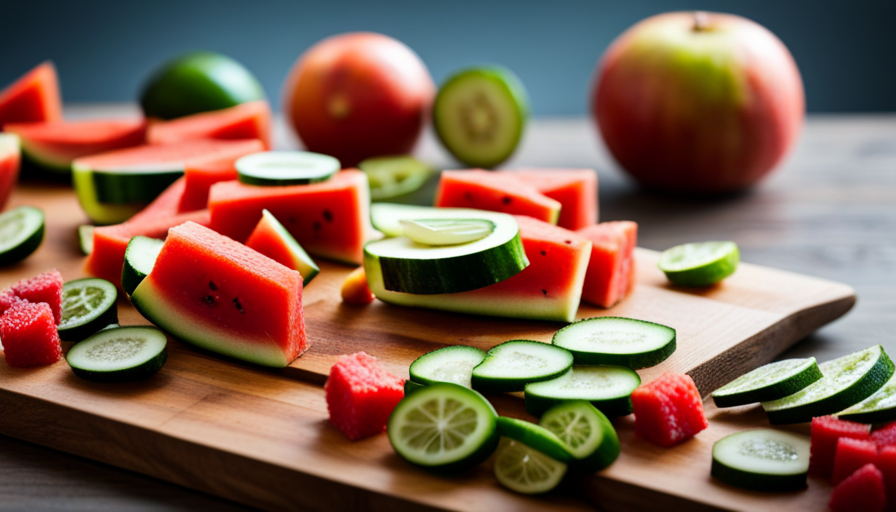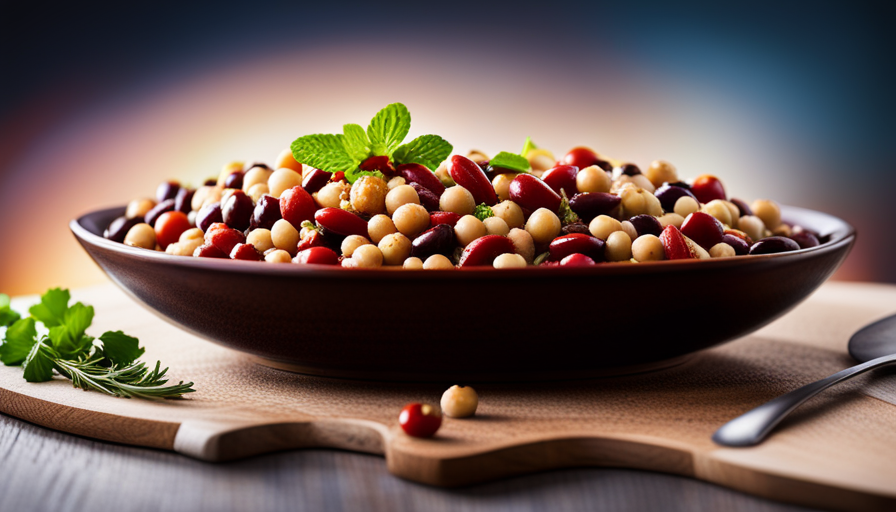Did you know that soups made from raw ingredients are not only delicious but also packed with essential nutrients?
In fact, studies have shown that consuming raw vegetables can help improve digestion, boost energy levels, and promote overall health.
If you’re looking for a refreshing and nutritious meal option, making raw food soup is the way to go.
With the right ingredients and preparation tools, you can easily whip up a flavorful bowl of goodness in no time.
In this article, we will guide you through the process of making raw food soup, from selecting the perfect ingredients to adding delicious garnishes and toppings.
Whether you’re a seasoned raw food enthusiast or just starting your journey, our tips and tricks will help you create a variety of raw food soups that are both satisfying and nourishing.
Get ready to embrace the raw food revolution and enjoy the benefits of this vibrant and wholesome culinary experience.
Key Takeaways
- Raw food soups are a delicious and nutritious option, packed with enzymes, vitamins, minerals, and antioxidants.
- Selecting fresh, high-quality, and organic ingredients is crucial for maximizing the nutritional value of raw food soups.
- Raw food soups can be made in a variety of flavors and textures by combining different vegetables, herbs, spices, and creamy ingredients like avocado or cashews.
- Enhancing the flavors of raw food soups with herbs, spices, citrus juice, olive oil, and garnishes like fresh herbs, toasted nuts, seeds, or zesty citrus zest adds freshness, texture, and visual appeal.
Benefits of Raw Food Soup
You’ll love how raw food soup nourishes your body with vibrant, colorful ingredients that burst with flavor and vitality. Raw food soup offers a plethora of health benefits and is packed with high nutritional value.
One of the key health benefits of raw food soup is its ability to preserve the natural enzymes present in the ingredients. Enzymes are essential for proper digestion and nutrient absorption. By consuming raw food soup, you’re providing your body with a rich source of enzymes, which can improve digestion and overall gut health.
Additionally, raw food soup is known for its high nutritional value. Raw vegetables and fruits are abundant in vitamins, minerals, and antioxidants that are often lost through cooking. By enjoying raw food soup, you can ensure that you’re getting the maximum amount of nutrients from your ingredients.
Furthermore, raw food soup is a fantastic way to incorporate more plant-based foods into your diet. It allows you to consume a variety of vegetables and fruits in one delicious meal. These plant-based ingredients are low in calories and high in fiber, making raw food soup an excellent choice for weight management and overall health.
Raw food soup provides numerous health benefits and is a great way to increase your nutritional intake. Incorporating raw food soup into your diet can promote better digestion, enhance nutrient absorption, and support overall well-being.
Choosing the Right Ingredients
When picking out the ingredients for your healthy broth, be sure to go for the freshest produce and avoid any wilted or mushy veggies. Choosing fresh ingredients is crucial to maximizing the nutritional value of your raw food soup.
Here are four key factors to consider when selecting your ingredients:
-
Quality: Opt for organic produce whenever possible, as it’s free from harmful pesticides and chemicals. This ensures that you’re getting the highest quality ingredients for your soup.
-
Seasonality: Select fruits and vegetables that are in season. Not only are they more flavorful, but they also contain higher levels of vitamins and minerals. Plus, buying in season helps support local farmers.
-
Color variety: Aim for a rainbow of colors in your soup. Different colors indicate a variety of nutrients, so including a mix of vibrant fruits and vegetables ensures you’re getting a wide range of beneficial compounds.
-
Texture and taste: Consider the texture and taste of the ingredients. Choose a combination of crisp and crunchy vegetables, as well as softer ones, to create a well-balanced soup. This’ll add depth and complexity to the flavors.
By carefully selecting fresh ingredients, you can create a raw food soup that’s not only delicious but also packed with essential nutrients.
Raw Food Soup Preparation Tools
Utilizing the appropriate tools is paramount in achieving optimal results while preparing a nourishing broth using uncooked ingredients. When it comes to making raw food soup, having the right kitchen gadgets can make all the difference.
Here are some essential tools you’ll need to ensure a successful soup-making experience:
-
First and foremost, a high-speed blender is a must-have tool for creating smooth and creamy soups. This powerful gadget can easily break down tough ingredients like carrots and kale, resulting in a silky texture that’s both satisfying and delicious.
-
Another essential tool is a spiralizer. This handy gadget allows you to turn vegetables like zucchini and sweet potatoes into long, noodle-like strands. Adding these veggie noodles to your soup not only adds texture but also boosts the nutritional value of your dish.
-
A dehydrator is also a valuable tool for making raw food soup. It can be used to gently dry ingredients like tomatoes and mushrooms, intensifying their flavors and adding a unique depth to your broth.
-
Lastly, a good quality knife set is essential for chopping and dicing your ingredients with precision. Having sharp, reliable knives will make the prep work much easier and more efficient.
Having the right raw food soup tools, such as a high-speed blender, spiralizer, dehydrator, and knife set, is crucial for creating a nourishing and flavorful broth. Invest in these essential kitchen gadgets, and you’ll be well on your way to enjoying a delicious and nutritious bowl of raw food soup.
Basic Raw Food Soup Recipe
To whip up a scrumptious bowl of this nourishing broth, all you need is a handful of fresh veggies, a splash of tangy lemon juice, and a sprinkle of aromatic herbs and spices. Making a basic raw food soup is incredibly easy and allows for endless variations to suit your taste preferences.
Start by choosing a variety of colorful vegetables such as carrots, bell peppers, cucumbers, and tomatoes. Wash and chop them into small, bite-sized pieces.
In a blender or food processor, combine the veggies with a squeeze of lemon juice to add a refreshing tanginess. You can also experiment with different herbs and spices like basil, cilantro, cumin, or ginger to enhance the flavors. Blend until smooth or leave it slightly chunky for added texture.
Raw food soup recipes are incredibly versatile, allowing you to get creative with the ingredients you have on hand. You can add avocado for a creamy texture, coconut water for a tropical twist, or even a dash of hot sauce for a spicy kick.
Serve chilled or at room temperature, and garnish with fresh herbs or a drizzle of olive oil. Enjoy the vibrant flavors and nourishing goodness of this simple yet satisfying raw food soup.
Creamy Raw Food Soup Variations
Get ready to indulge in a luscious and velvety blend of fresh ingredients that’ll take your taste buds on a tantalizing journey with these creamy variations of raw soup. When it comes to creamy soup recipes, the possibilities’re endless. By using a variety of raw food soup ingredients, you can create a delicious and nutritious dish that’ll satisfy even the pickiest eaters.
One popular creamy raw food soup variation’s the avocado and cucumber soup. The creamy texture of the avocado combined with the refreshing taste of cucumber creates a perfectly balanced soup that’s both creamy and light. To make this soup, simply blend avocados, cucumbers, lemon juice, garlic, and salt until smooth. You can garnish it with fresh herbs like cilantro or dill for an added burst of flavor.
Another delicious option’s the cashew and red pepper soup. Cashews’re known for their creamy texture when blended, making them the perfect base for a creamy soup. Combine soaked cashews, red bell peppers, onion, garlic, vegetable broth, and spices like cumin and paprika in a blender until smooth. The result’s a rich and satisfying soup that’s bursting with flavor.
These creamy raw food soup variations’re not only delicious but also packed with nutrients. Give ’em a try and elevate your raw food soup game to a whole new level of creaminess and taste.
Hearty Raw Food Soup Options
Indulge in the rich and satisfying flavors of hearty raw soups that’ll nourish your body with their nutrient-packed ingredients. These hearty raw food soup recipes aren’t just delicious, but they also offer a multitude of health benefits. Here are four options to tantalize your taste buds and boost your well-being:
-
Chunky Vegetable Soup: Packed with an array of colorful veggies like carrots, bell peppers, and zucchini, this soup provides a burst of vitamins, minerals, and antioxidants. The crunchy texture of the vegetables adds a delightful contrast to the creamy base.
-
Spicy Lentil Soup: This soup combines the heartiness of lentils with a kick of spice. Lentils are a great source of plant-based protein, fiber, and iron, making this soup both filling and nutritious. The spices not only add flavor but also provide anti-inflammatory properties.
-
Creamy Avocado Soup: Creamy, smooth, and velvety, this soup is a true treat for the senses. Avocados aren’t just delicious but also offer a wealth of healthy fats, vitamins, and minerals. This soup is perfect for those looking to indulge in a satisfying meal while still maintaining a raw food diet.
-
Nutty Mushroom Soup: Earthy mushrooms combined with a blend of nuts create a rich and savory soup. Mushrooms are known for their immune-boosting properties, while nuts provide healthy fats and protein. This soup will keep you warm and satisfied on chilly days.
These hearty raw food soup recipes aren’t just delicious but also offer numerous benefits such as increased energy, improved digestion, and enhanced immune function. Incorporate them into your diet and experience the nourishing power of raw soups.
Adding Flavor and Texture to Raw Food Soups
Now that you’ve explored some hearty options for raw food soups, let’s dive into the exciting world of enhancing flavors and creating different textures. Adding flavor to raw food soups is all about using the right ingredients and techniques to bring out the best in each bite.
Start by incorporating aromatic herbs and spices like basil, cilantro, ginger, or cumin to give your soup a burst of fresh and vibrant flavors. You can also experiment with adding a splash of citrus juice or a drizzle of high-quality olive oil to elevate the taste.
To create a variety of textures in your raw food soups, consider using a combination of crunchy and creamy ingredients. For a satisfying crunch, try adding diced vegetables like bell peppers, cucumbers, or carrots. You can also sprinkle in some toasted nuts or seeds for added texture.
To achieve a creamy consistency, blend in avocado, coconut milk, or soaked cashews. These ingredients not only enhance the texture but also provide a creamy richness to your soup.
Remember, the key to creating a delicious raw food soup lies in finding the perfect balance of flavors and textures. Don’t be afraid to experiment and adjust the ingredients according to your taste preferences. By incorporating different flavors and textures, you can elevate your raw food soups to a whole new level of culinary delight.
Raw Food Soup Garnishes and Toppings
To take your raw food soup to the next level, don’t forget to add a variety of delicious garnishes and toppings that’ll enhance both the presentation and flavor. These simple additions can transform an ordinary soup into a culinary masterpiece.
Here are some raw food soup garnish ideas and creative toppings that you can try:
-
Fresh Herbs: Sprinkle some chopped cilantro, basil, or mint on top of your soup. The vibrant colors and fragrant aromas won’t just add visual appeal but also elevate the taste.
-
Crunchy Nuts and Seeds: Toasted almonds, pumpkin seeds, or sunflower seeds are excellent options for adding texture and a satisfying crunch to your soup. They also provide a dose of healthy fats and proteins.
-
Zesty Citrus Zest: Grate some lemon or lime zest over your soup to add a burst of freshness and tang. The citrus flavor will complement the other ingredients and awaken your taste buds.
These garnishes and toppings won’t just enhance the overall look and taste of your raw food soup but also provide additional nutrients and textures. Experiment with different combinations to find your favorite flavors. So, get creative and elevate your raw food soup to a whole new level with these fantastic ideas!
Storing and Freezing Raw Food Soups
If you’re looking to preserve the flavors and nutrients of your homemade raw soup, storing it in airtight containers or freezer bags is like putting it in a time capsule, keeping it fresh and ready to enjoy whenever you desire. Freezing raw food soups is an excellent way to extend their shelf life and ensure that you always have a healthy meal option on hand. To preserve freshness, it’s important to follow proper freezing techniques.
Here are some tips for storing and freezing raw food soups:
-
Use airtight containers or freezer bags: These will prevent air from entering the soup, which can cause freezer burn and affect the taste and texture.
-
Leave some headspace: When filling the containers or bags, leave about an inch of space at the top to allow for expansion as the soup freezes.
-
Label and date: Always label your containers or bags with the date and contents, so you can easily identify them later.
-
Freeze individual portions: If you prefer to have single servings, freeze the soup in individual containers or bags for convenience.
-
Thawing and reheating: To thaw, transfer the soup from the freezer to the refrigerator and let it thaw overnight. When reheating, gently heat the soup on the stovetop or in the microwave until it reaches your desired temperature.
By following these freezing techniques, you can enjoy the freshness and flavors of your homemade raw food soups even after they have been stored in the freezer.
Raw Food Soup Tips and Tricks
Looking for some handy tips and tricks to take your homemade soup game to the next level? Well, you’re in luck! When it comes to raw food soup, presentation is key. You want your soup to look as appetizing as possible, so consider garnishing it with fresh herbs, a drizzle of olive oil, or a sprinkle of chili flakes.
Another idea is to serve your soup in unique and creative ways, such as in hollowed-out vegetables or shot glasses for a fun and interactive dining experience.
Now, let’s talk about ingredients. Raw food soups offer a world of possibilities when it comes to unique ingredients. Think outside the box and experiment with different fruits, vegetables, and herbs. Some unexpected additions that can add a burst of flavor include mango, avocado, coconut milk, and even edible flowers. Don’t be afraid to mix and match to create your own signature raw food soup recipe.
To make your raw food soup even more exciting, try incorporating textures. You can add crunch by topping your soup with toasted nuts or seeds, or create a creamy texture by blending in soaked cashews or sunflower seeds. The possibilities are endless!
By following these tips and tricks, you’ll be able to create visually stunning and delicious raw food soups that will impress your family and friends. So go ahead, get creative, and enjoy the wonderful world of raw food soup!
Frequently Asked Questions
Can raw food soups be served hot?
Raw food soups can indeed be served hot, although it goes against their natural essence. Like a delicate flower blooming in the scorching sun, serving raw food soups hot can provide a unique experience. The pros include a comforting warmth and intensified flavors. However, it may compromise the nutritional content and destroy some beneficial enzymes. To add a creative touch, garnish with fresh herbs, sprouts, or a drizzle of cold-pressed oils for contrasting temperatures and textures.
Can I use a regular blender to make raw food soup?
Yes, you can use a regular blender to make raw food soup. While there are blender options specifically designed for raw food preparation, a regular blender can still get the job done. However, it’s important to note that a high-powered blender will yield smoother results.
If you don’t have access to a blender, alternative methods like using a food processor or immersion blender can also be used to make raw food soup.
How long can raw food soups be stored in the refrigerator?
Raw food soups can be stored in the refrigerator for up to 3-4 days, but it’s important to follow proper storage tips to maintain their freshness. To maximize shelf life, ensure that the soup is stored in an airtight container to prevent contamination and odors from other foods. It’s also advisable to label the container with the date it was made.
Always inspect the soup before consuming and discard if it shows any signs of spoilage.
Can I use frozen vegetables in raw food soups?
Using frozen vegetables in raw food soups can be a convenient option, but it may not provide the same benefits as using fresh ingredients. Think of it like this: imagine you’re in a tropical paradise, sipping a freshly squeezed juice made from ripe, hand-picked fruits. The taste and nutritional value are unmatched.
Similarly, fresh vegetables in raw food soups offer vibrant flavors and higher levels of vitamins and minerals compared to their frozen counterparts. So, whenever possible, opt for fresh ingredients to maximize the goodness of your raw food soups.
Can I add cooked ingredients to raw food soups?
Yes, you can add cooked ingredients to raw food soups, but it’s important to understand the difference between cooked and raw ingredients. Raw food soups are known for their numerous health benefits, including higher nutrient content and easier digestion. However, adding cooked ingredients, such as cooked vegetables or grains, can provide a different texture and flavor profile. Just be mindful that cooking may reduce some of the nutritional value of the ingredients.
Can Raw Food Tortillas Be Used as a Base for Raw Food Soup?
Yes, a raw food tortilla recipe can be used as a base for a raw food soup. The tortilla can be chopped or torn into pieces and added to the soup as a nutritious and flavorful ingredient. This provides a unique twist on traditional soup recipes and adds an extra dimension to the dish.
Conclusion
As you sip on a warm and comforting bowl of raw food soup, you can’t help but feel a sense of rejuvenation and vitality. Each spoonful symbolizes a nourishing journey towards better health and well-being.
By following the precise steps and techniques outlined in this article, you’ve unlocked the power of raw food soups and all their benefits. So, whether you choose to indulge in a creamy variation or experiment with different flavors and textures, remember that each bowl holds the key to a vibrant and delicious culinary experience.
Don’t forget to store and freeze your creations for future enjoyment. Cheers to a life filled with vibrant raw food soups!










